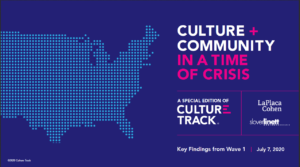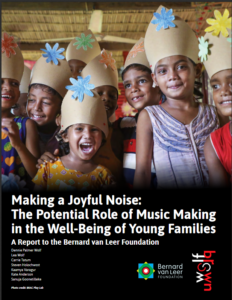August
2020
August 3, 2020
From the Field
Culture + Community in a Time of Crisis
 Culture Track, a reoccurring national audience survey, gathered 124,000 respondents this spring to assess cultural participation and motivation in the wake of COVID-19. Findings from the first wave of the survey showed that respondents feel more worried, bored and disconnected from others, and look to the arts and culture for connection, escape, and emotional and practical support. The survey found that black, indigenous and people of color have been disproportionately affected economically and physically by the pandemic, and that respondents want and expect cultural institutions to play more inclusive roles in their communities.
Culture Track, a reoccurring national audience survey, gathered 124,000 respondents this spring to assess cultural participation and motivation in the wake of COVID-19. Findings from the first wave of the survey showed that respondents feel more worried, bored and disconnected from others, and look to the arts and culture for connection, escape, and emotional and practical support. The survey found that black, indigenous and people of color have been disproportionately affected economically and physically by the pandemic, and that respondents want and expect cultural institutions to play more inclusive roles in their communities.
What Do Artists Need?
The National Performance Network reached out to artists around the United States to ask “What do you need?” The video responses to this research question were collected from individual artists and are available for view. Some needs artists expressed include: unrestricted funding, health care, investment in process-oriented work, reparations and rest.
LA County Adopts Countywide Cultural Policy
In a first for counties across the United States, Los Angeles County, California, adopted a comprehensive Countywide Cultural Policy on June 23. The process of creating the policy began in 2017 after it was one of five funded recommendations from the LA County Arts Report: Cultural Equity & Inclusion. Offering guidance for all county departments, the policy establishes the Department of Arts and Culture as a leader in promoting investment in cultural infrastructure, integrating arts and culture into everyday civic life, and supporting “cultural equity, diversity, inclusion, and belonging.” Importantly, this framework is centered around the recognition that arts and culture are a necessary part of quality of life and resilient communities, and that access to cultural resources and benefits is still unequal.
Making a Joyful Noise
 In a new report, Making a Joyful Noise: The Potential Role of Music Making in the Well-Being of Young Families, WolfBrown together with the Bernard van Leer Foundation explore the role of music in supporting early childhood development. Combining a literature review and case studies, the report cites studies on how music nurtures childhood growth and the ways music programing is implemented across four sectors: health of the family, public spaces, engaged learning and inclusive cultural opportunities. The report also provides a list of action steps to make “concerted use of the low-cost, potentially high impact of music” to support children’s well-being.
In a new report, Making a Joyful Noise: The Potential Role of Music Making in the Well-Being of Young Families, WolfBrown together with the Bernard van Leer Foundation explore the role of music in supporting early childhood development. Combining a literature review and case studies, the report cites studies on how music nurtures childhood growth and the ways music programing is implemented across four sectors: health of the family, public spaces, engaged learning and inclusive cultural opportunities. The report also provides a list of action steps to make “concerted use of the low-cost, potentially high impact of music” to support children’s well-being.
The Road Forward
The National Endowment for the Arts has released guidance for arts organizations on re-engaging with audiences and visitors. The Road Forward offers a curated collection of recommendations for social distancing, sanitation, creating accessible virtual events and communicating safety requirements. The tip sheet contains a selection of resources for reopening and/or moving online for a variety of arts and cultural organizations.
Audience Outlook Monitor
WolfBrown’s Audience Outlook Monitor is designed to provide guidance on how and when to reopen venues by gauging audiences’ perceptions on returning to live events. Through a collaboration with 22 global partners totaling 517 organizations, WolfBrown has collected more than 142,892 survey responses. As of now, phase 1 results are available for Ontario, Southeast Michigan and Atlanta.
Using data gathered by this audience survey, New Details Emerging on Interest in Digital Performances found that 13% to 29% of respondents have participated in a digital offering in select U.S. regions. Although in its initial stages, the Audience Outlook Monitor will continue to be a resource for collecting and interpreting audiences’ desire to view and return to arts and cultural activities during the pandemic.
PPP Data on Preserving Jobs in the Arts & Culture Sector
SMU DataArts analyzed data from the Paycheck Protection Program to see how the arts and culture sector benefited from federal loans designed to keep small businesses afloat during the pandemic. It discovered that nonprofit arts and culture received $1.1 billion among 5,713 organizations averaging $194,191 each. The loans supported 117,805 jobs—about 22 per organization.
In this Issue
From the President and CEO
State to State
Legislative Update
The Research Digest
Announcements and Resources
More Notes from NASAA
SubscribeSubscribe
×
To receive information regarding updates to our newslettter. Please fill out the form below.
